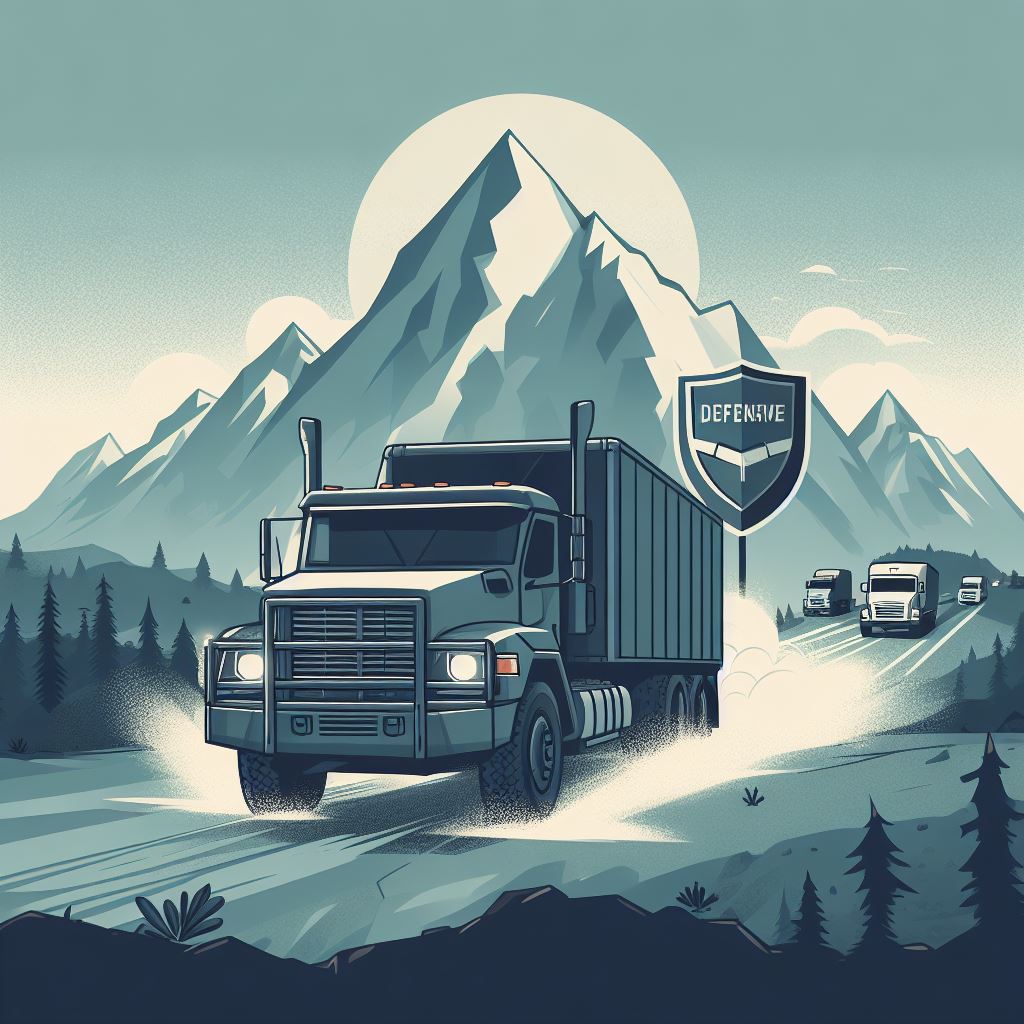Trucking Safety Tips: How to Stay Safe on the Road?
Congratulations on obtaining your CDL and embarking on your trucking career! As you hit the road to deliver goods across the country, you’ll face a unique set of challenges and risks.
From long hours and unpredictable weather to navigating busy highways and dealing with other motorists, trucking can be a demanding profession. But with the right safety precautions, you can minimize your risks and ensure a successful and rewarding career.
In this article, we’ll provide you with essential trucking safety tips that every trucker should adopt. These tips will help you stay safe on the road, protect your cargo, and avoid accidents.
Life as a trucker means spending long hours on the road, striving to meet delivery deadlines and excel in your profession.
However, this demanding lifestyle exposes you to numerous unforeseen hazards that could disrupt your entire operation, leading to costly downtime. While truck insurance provides financial protection in case of an incident, proactive safety measures on the road can transform your trucking experience.
The trucking industry is not without its perils. According to the U.S. Department of Labor, trucking ranks among the most dangerous occupations. In 2004 alone, cargo moving companies and transportation services accounted for the highest number of fatal work-related injuries.
While risk is inherent in the trucking profession, proactive measures can significantly minimize both likely and unlikely accidents encountered on a daily basis. By adopting essential trucking safety tips, you can safeguard your well-being, protect your cargo, and ensure the smooth operation of your trucking business.
To reap the rewards of a lucrative and fulfilling trucking career, it’s crucial to prioritize safety on the road.
10 Trucking Safety Tips that Help Drivers Stay Safe And Minimize Accidents On the Road
The growing number of trucking companies and elevating demand for transportation services have resulted increased number of trucks on the road. Also, the pressure of meeting timelines among truckers is quite high which leads to hasty driving and fatigue which increases the risk of accidents on the roads. To make the entire operation safer, you need to familiarize yourself with safe driving tips for truck drivers.
Here is a list of essential trucking safety tips that every driver should adopt.
Advance Trip Planning


Planning a trip substantially increases your safety. Watching speed up videos from your destination will help you capture a condensed yet comprehensive view of local conditions, ensuring a more efficient and informed trip planning process. Your trip planning should be aligned with the type of area you are traveling to or potential risks in that region, such as:
Congested Traffic
Areas that have high traffic congestion have more chances of accidents as vehicles move very close to each other. If you are traveling to a congested traffic route, know the path you are driving and slow down whenever you need to. You can also take alternative routes, if possible.
Crime-prone Areas
The Cargo that you transport is the main target of thieves and people who have malicious intent. Cargo thefts can also lead to violent crime against truck drivers as well. In such cases, you should avoid stopping in unsafe, poorly lit, and isolated areas. Plan your halts and stop in safe and crowded places only.
Restricted Paths
You need to avoid areas and routes that are restricted for trucks. Check the weight limit of bridges beforehand as returning can eat up a lot of time and cause delays in your deliverable which will affect your reputation as well.
Weather Conditions
Stay up-to-date with the current weather conditions that you are planning to travel with your truck and shipment. If it indicates that the weather is inclement, try diverting your route and taking the alternative path or you can plan hauling in the next day when the conditions are normal (if possible).
Periodic Maintenance
Maintaining your trucks is as important as any other aspect of your trucking business. Issues with truck maintenance can lead to frequent repairs and even tractor-trailer accidents. We understand that trucking is a very occupying business, so you might have skipped on this part. If you don’t maintain your vehicle periodically due to any reason, try developing a maintenance schedule for your trucks.
You can coordinate with your mechanic to plan a preventive maintenance schedule for your commercial vehicle. If you are working on a lease, you can contact your company to know more about the periodic maintenance schedule of the truck.
Right Cargo Loading
Cargo is the lifeblood of any trucking business. However, loading the cargo improperly poses risks to the driver and is prone to getting damaged as well. An insecure load of cargo can put pressure on the tractor-trailer in a single area which can make it go out of control while driving the truck. You need to load the cargo correctly to prevent it from falling on the roadway or shifting which leads to damage. This is one of the vital trucking safety tips on our list.
You need to utilize load securement devices to do it properly. For refrigerated shipments, using airbags, load locks, and cinch straps is highly recommended as it keeps them from shifting. For flatbed trailers, you can use chains and straps that your cargo needs. Please note, that you need to adhere to DOT regulations for flatbed load securing.
Defensive Driving
It is not always the case that accidents are caused by you or your driver’s mistake. Most of the time, other drivers on the road are at fault for an incident. In such cases, you have no control over other driver’s actions or you cannot sit and assume that they are driving safely. Many large truck drivers are unaware of the safety measures around a huge vehicle as theirs.


According to a study by the University of Michigan Transportation Institute, most fatal crashes and accidents involving large trucks are not caused by the drivers. 81%-91% of such crashes happen due to other auto or car’s fault. Therefore, you need to drive defensively. You can follow these defensive trucking safety tips to stay on point.
Blind Spots
As a trucker, you need to be aware of your blind spots. Every 3-5 seconds you need to check all the mirrors to maintain complete awareness. Keep checking how far the vehicles are behind your trailer and on the passenger side of the door, etc.
Safe Distance
You need to keep a safe distance from all the vehicles moving behind, side by side, and in front of your truck to avoid hitting them or getting impacted.
Stay Calm
If you observe unsafe traffic behavior or other motorists are instigating you, slow down for a while and avoid getting agitated. Try staying calm, especially when driving at high speed on interstate highways, this will help to minimize potential dangers.
Use Truck Atlas and Other Essential Tools
Using GPS, truckers can ensure that they are on the right route. However, this technology should not be the only tool to follow because sometimes they are not reliable. To avoid delays and drive on the right route, use Truck Atlas. This tool will help you plan alternative routes in case of high traffic congestion, construction zones, etc.
Avoid Distractions
Distractions are one of the primary reasons that lead to accidents on the roadways. According to FMCSA, crashes, lane deviation, or near-crash situations occur when a driver uses phones for texting, calling, etc. while driving. In the US, distracted driving led to 3100 deaths and 424000 injuries in 2019. According to NHTSA, distracted driving is very dangerous as it claimed 3522 lives in 2021.
Additionally, to check mobile or texting, individuals take their eyes off the road for 4.6 seconds. 3.7% of young drivers between 16 to 24 years engage in using their phone while driving in 2021. Whereas, drivers between 25 to 69 years of age use 2.5% of the phone while driving. So, if a driver is driving at 55 mph, it can quickly collide with another vehicle.
Want to insure your fleets? Get free truck insurance quote now.


Preparations for Road Conditions
The conditions of roadways keep changing constantly. This can be dangerous to all truck drivers who drive large commercial vehicles. Here is a list of some common hazards that you need to watch out for.
- Snow
- Icy Road
- Fog
- Disabled Vehicles
- Rain
- Animals
- Road Construction
- Accidents
You need to pay attention to the road and weather conditions report. Make sure that your marker lights and flashers are working and visible to other drivers on the road. Drive slowly when passing disabled vehicles or avoid striking animals on the road. Check for a speed limit and other warning signs on the road.
Adequate Breaks
Fatigue is another major cause leading to accidents on the road. You need to take an adequate amount of breaks in your journey to lower the fatigue. To drive safely, many seasoned drivers recommend resting and stopping whenever drivers feel fatigued.
Driving a vehicle while fatigued is similar to driving it under the influence of alcohol or drugs. Keeping this concern in mind, FMCSA has created HOS regulations (Hours of Service) for commercial vehicle drivers.
Here is the list of HOS by FMCSA:
- 14 hours of duty time in a 24-hour time.
- 30 minutes of break before 8 hours of driving.
- 11 hours of driving in a 24-hour time.
- 10 hours of sleep to resume 11 hours driving and 14 hours of duty time.
Increase Awareness
As a good trucker, you need to have a good awareness of what is happening around you at every time to avoid potential risks that lead to accidents. Keep checking your side mirrors every 3-5 seconds. Make sure you are using indicator lights whenever you make a turn or lane change.
Whenever you are reversing your truck, make sure you look out. If you aren’t sure, get out and walk around 360 degrees of your truck to see objects, hazards, or individuals near the vehicle. Always honk before reversing and use 4-way flashers. Check 2-3 times before changing lanes.
Pre and Post-driving Inspections


Pre and post-driving inspection is very crucial to spot the defects of your vehicle and equipment that can bring grave consequences. Federal regulations require every commercial truck driver to follow a pre-trip inspection checklist once a day. Inspections are the first line of defense to operate safely only on the road and should not be disregarded for trucker safety.
Here is the pre-trip inspection checklist for every driver:
- Braking system: Check your air brake lines, air compressor, brake pads, calipers, rotors, or drums, brake lights, and low air pressure alarm.
- Steering system: Inspect power steering fluid, steering column, pinions, rack components, and steering tires.
Frequently Asked Questions About Trucking Safety Tips
All the aforementioned truck safety tips can help you be the safest driver.
The large blind spots on the front of the trailer and both sides of the tractor are dangerous areas of a commercial vehicle.
As a driver, you should keep at least a two-second distance from the vehicle moving in front of you. It gives you time to react when something happens.
If a trucker is hauling hazardous cargo that can lead to intoxication, explosions, or chemical burns, there is an increased risk for drivers transporting such shipments, especially during the long haul.
Avoid stopping at isolated locations or areas which are not well-lit. When you stop, check and be aware of your surroundings, especially during the night.
The Bottomline: Trucking Safety Tips
Safety in trucking is crucial. So, operating carefully, driving precautiously, and returning home safely in one piece should be your top priority.
If road conditions are bad, slow down or just stop for a while. If your phone is ringing or someone is texting, don’t check it hastily, it can wait. You can check it afterwards because 4.6 seconds might sound very tiny but it can take people’s lives like that.
Make sure you follow all the trucking safety tips we shared with you in this article.
Adopt them and be the safest driver in the country!






